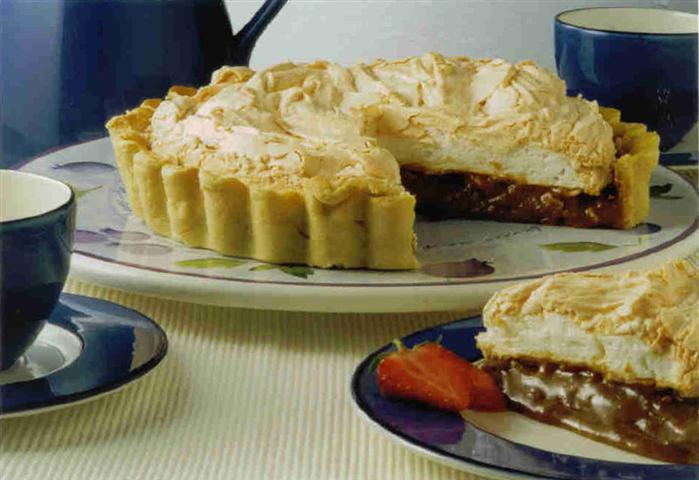
Denise says:
The crunchiness of meringue together with the sweetness of butterscotch produce a very delicious dessert especially desirable for those who have a sweet tooth!
Caramel is simply sugar cooked to the point where it melts and burns and butterscotch is similar except that butter is added to the sugar as it caramelises. This subsequently gives it a nutty taste. You can make caramel either by stirring dry sugar in a pot over a flame or with the addition of water. It is crucial that the sugar is fully dissolved before the syrup is allowed to boil otherwise it may crystallise. If this happens add some bicarbonate of soda and this will help to break down the sugar. Continue to cook the syrup until it turns a deep amber colour and begins to smoke – but stop before it becomes reddish or mahogany. If over cooked, the syrup will taste bitter and salty. Be prepared for the caramel to ‘spit’ with the addition of the milk, butter or cream and it is at this stage you must stir the mixture vigorously to produce a smooth consistency. Should some of the caramel refuse to melt, set the pan over the heat again.
Preparation Time: 30 minutes plus 30 minutes pastry resting time
Cooking Time: 55 minutes
Serves: 6 people
Ingredients:
For the Pastry250g (9 oz) plain flour
110g (4 oz) unsalted butter
1 teaspoon vanilla essence
1 tablespoons icing sugar
1 egg
1 egg yolk – for glazing
For the Filling and Topping
250g ( 9 oz) light brown sugar
75g (3 oz) plain flour
250ml ( 8 fl oz) evaporated milk or double cream
4 large eggs – separated
1 tablespoon – unsalted butter – cut into pieces
1 teaspoon vanilla essence
Pinch of salt
55g ( 2oz) caster sugar
Method
1)Pre-heat the oven to 200ºC/400ºF/Gas mark 6.2)Make the pastry by combining all the ingredients in a food processor and whiz together until a dough has formed.
3)Wrap in cling film and place in the refrigerator to rest for a minimum of 30 minutes.
4)Lightly flour the work surface before rolling out the pastry to fit a 23cm (9 inch) loose-bottom baking tin.
5)Cover with foil, fill with baking beans and bake blind for 20 minutes.
6)Remove the foil and baking beans and glaze the cooked pastry with the egg yolk. Return to the oven for a further 5 minutes. Lower the temperature of the oven to 150ºC/300ºF/ Gas mark 2.
7)In a medium sized saucepan, mix together the brown sugar and flour. Whisk in 50ml (2 fl oz) of water and the evaporated milk or double cream. Simmer over a low heat for 5 minutes or until the mixture is smooth.
8)Remove from the heat and whisk in the egg yolks, one at a time, and then the butter and vanilla essence. Leave to cool while you make the topping and then pour into the cooked pie base.
9)Line a baking tray with baking parchment paper. Make a template by drawing around the pie base tin.
10)Using a mixer, whisk up the egg whites with a pinch of salt until stiff. Add the sugar a tablespoon at a time.
11)Pipe or spoon the meringue onto the template.
12)Bake in the pre-heated oven for 20 minutes or until golden brown.
13)Allow the meringue to cool a little and then carefully place on top of the set butterscotch pie. (This may need to be trimmed to fit snugly – use sharp scissors or a serrated knife!)
To serve the stylish way: Place some strawberries/ blueberries around the edge of the pie. It will last 3 or 4 days but will not freeze.
